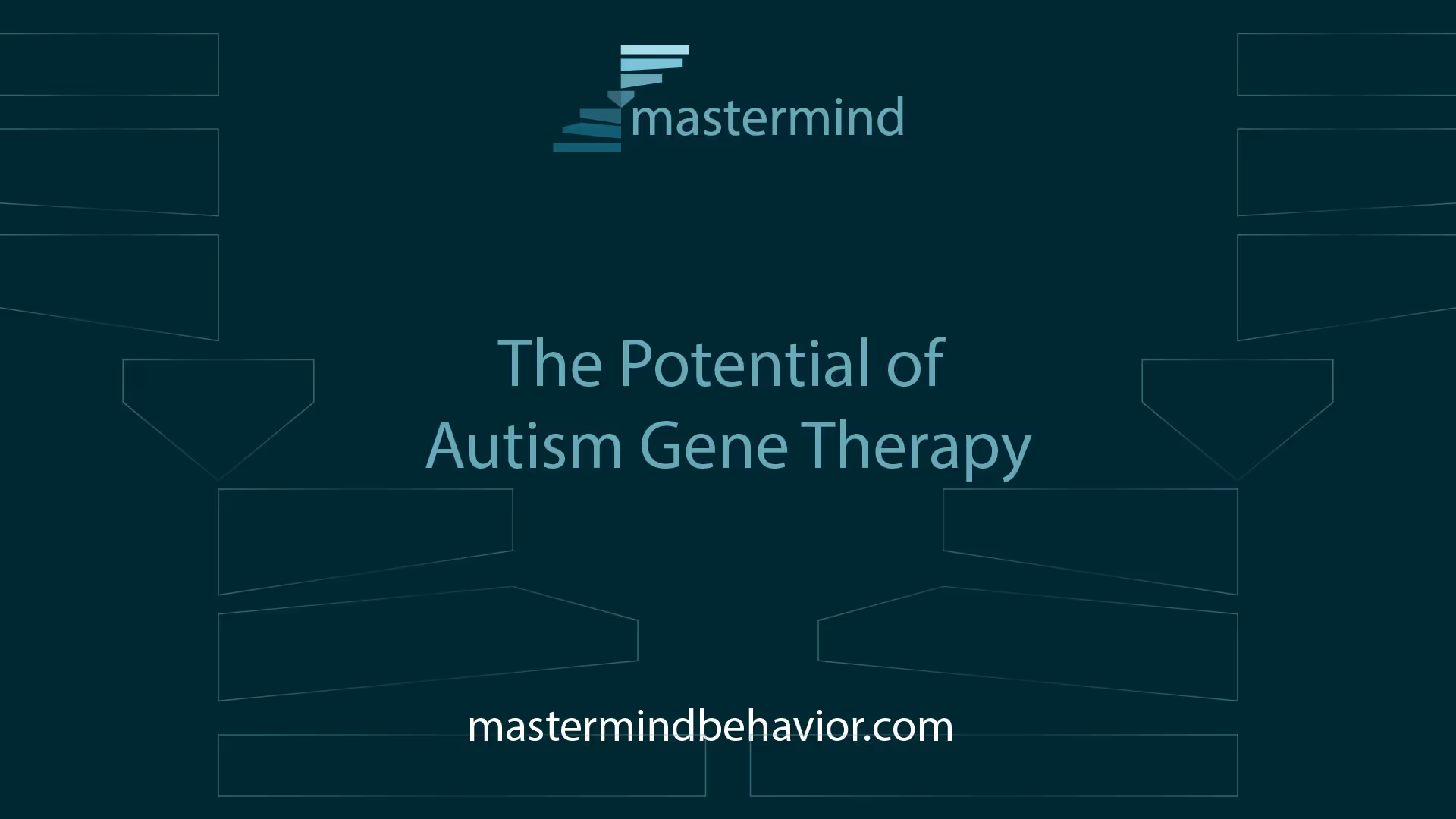The Potential of Autism Gene Therapy


Understanding Gene Therapy
Gene Therapy Basics
Gene therapy is a groundbreaking technique that involves modifying a person's genes to treat or cure various diseases, including cancer, genetic disorders, and infectious diseases. According to the FDA, this innovative approach aims to address the root causes of diseases rather than just their symptoms.
Gene therapy can involve several methods, including:
Current research is exploring the potential of gene therapy to treat autism spectrum disorder (ASD). Understanding autism at a genetic level is essential for developing targeted therapies to address the underlying causes of these conditions.
Clinical Applications of Gene Therapy
Gene therapy has seen significant clinical applications in various fields, particularly in neurology. Some notable examples include:
ConditionGene Therapy ProductDescriptionSpinal Muscular Atrophy (SMA)NusinersenAn antisense oligonucleotide therapy that modifies the SMN2 gene, improving motor function.Leber's Congenital AmaurosisLuxturnaA viral-based gene replacement strategy that addresses a specific genetic defect leading to blindness.Blood CancersCAR T-cell TherapyA customized treatment that modifies a patient’s T cells to attack cancer cells.
These therapies mark significant advancements in the field, with a focus on improving patient outcomes and quality of life. The establishment of protocols and regulatory pathways, such as the submission of an Investigational New Drug application (IND) and a Biologics License Application (BLA) for marketing, are crucial steps in bringing gene therapies to clinical use.
Understanding the clinical implications of gene therapy lays the groundwork for future advancements, including its potential application in treating autism. For more information on the genetic aspects of autism, consider exploring genetic causes of autism or autism spectrum disorder genetics. Additionally, genetic counseling can help families navigate these complex topics, available through resources on genetic counseling for autism.
Gene Therapy for Autism
Exploring the realm of autism gene therapy uncovers various advancements and techniques that show potential for aiding children with autism spectrum disorder (ASD). This section discusses the current landscape of gene therapy for autism and highlights promising approaches being investigated.
Current Landscape
The development of gene therapies is rapidly progressing, with an increasing number of therapies being researched for various conditions, including autism. As evidenced by studies, gene therapies are currently employed to manage diseases such as Leber congenital amaurosis and spinal muscular dystrophy [2]. Investments from pharmaceutical companies and startups are contributing millions of dollars toward gene therapy advancements, which could open new doors for treating genetic causes of autism autism spectrum disorder genetics.
As the field evolves, the following technologies are being explored for treating monogenic autism spectrum disorders:
Technology UsedDescriptionNoncoding RNAModulates gene expression without altering the genome.Antisense Oligonucleotides (ASO)Targets mRNA to modify gene expression.RNA EditingAdjusts RNA sequences to correct genetic abnormalities.Gene DeliveryFacilitates the introduction of therapeutic genes into cells.
These innovative strategies focus on altering gene expression levels to address specific autism-related genetic conditions without changing the host cell genome [3].
Promising Approaches
Among the promising techniques is the use of gene editing technologies like CRISPR/Cas9. This novel approach aims to correct disease-causing mutations within genes related to autism. Current research includes utilizing CRISPR-based methods such as CRISPR-HDR, base editing, and prime editing to make precise corrections at the transcriptome level [3]. Early studies indicate that these technologies have successfully corrected mutations linked to conditions like Rett syndrome and Phelan-McDermid syndrome.
Another significant development in autism gene therapy is the initiation of clinical trials by Jaguar Gene Therapy for a targeted genetic form of autism. The gene therapy, known as JAG201, has received the FDA's Rare Pediatric Disease designation and Fast Track designation due to its focus on SHANK3 haploinsufficiency and Phelan-McDermid syndrome. This trailblazing study aims to address the unmet medical needs in affected patients, with patient enrollment anticipated to begin in Q1 2025 [4].
As research continues to expand, these advancements bring hope for effective and personalized treatments for families facing the challenges of autism. To learn more about genetic factors associated with autism, explore our sections on genetic causes of autism and genetic counseling for autism.
Recent Developments in Autism Gene Therapy
Advances in Research
Significant progress has been made in the field of autism gene therapy. Recent studies have provided promising insights into the genetic underpinnings of autism spectrum disorder (ASD). An array of studies in various monogenic ASD animal models has demonstrated the possibility of reversing established neuronal dysfunction through either pharmacological intervention or genetic reactivation of silenced alleles [5]. This indicates that targeting specific genetic abnormalities could pave the way for new therapeutic strategies.
One of the groundbreaking initiatives is the development of Jaguar Gene Therapy's JAG201, which has recently received Rare Pediatric Disease designation and Fast Track designation by the FDA. This gene therapy aims to specifically address the high unmet medical need in patients diagnosed with ASD due to SHANK3 haploinsufficiency and Phelan-McDermid syndrome [4]. Dr. Alexander Kolevzon emphasizes the importance of early intervention for greater potential benefits in treating individuals with these genetic conditions.
Potential Treatments
The pipeline for autism gene therapy is gaining momentum with novel treatment approaches. JAG201 targets individuals with SHANK3 haploinsufficiency by delivering a functional SHANK3 minigene via an adeno-associated virus serotype 9 (AAV9) vector, which aims to reach the neurons in the central nervous system.
The progression to clinical trials marks a pivotal moment in autism gene therapy. Parents of children with ASD can remain hopeful for targeted therapies that may specifically address the genetic causes of autism. Ongoing research and development indicate a future where comprehensive approaches to autism treatment, blending genetic insights and therapeutic interventions, may become the norm.
The exploration of genetic causes of autism continues to expand, providing both hope and avenues for effective genetic counseling for autism. Understanding these advancements is vital for parents who are navigating these challenges and seeking information about potential treatments for their children.
Challenges and Considerations
As researchers explore the potential of autism gene therapy, several challenges and considerations arise. These include safety concerns and ethical implications, both of which are critical to address to ensure the responsible application of this innovative treatment approach.
Safety Concerns
Potential risks associated with genetic therapies include severe allergic reactions, organ damage, or even specific cancers, especially when injections are involved. While these risks cannot be overlooked, advancements in genetic therapies have improved safety features, leading to the FDA approving some gene transfer therapies for clinical use in the United States. This provides a more secure framework for the application of these treatments [6].
The evolving nature of genome editing technologies continues to be an area of study. Researchers are investigating the risks associated with newer methods to ensure that these therapies do not introduce unexpected complications.
Risk TypePotential ConsequenceAllergic ReactionsSevere responses requiring interventionOrgan DamageLong-term health implicationsCancerIncreased risk depending on therapy
Parents should keep informed about the latest research and guidelines around safety to make educated decisions for their children. For more information on the genetic aspects of autism, consider exploring topics such as genetic testing for autism and genetic causes of autism.
Ethical Implications
The introduction of gene therapy for autism raises important ethical considerations. These include questions about consent, access, and the long-term effects of manipulating genes. As many children are affected by autism spectrum disorder, discussions on who should receive treatment and how to distribute resources fairly among affected families are vital.
Additionally, the possibility of genetic modification generates debates about the potential for eugenics and the societal implications of altering genetic conditions. The desire to “cure” autism can overshadow the diverse experiences of neurodiverse individuals and their families.
Considering these perspectives is crucial to developing a framework that respects individual autonomy while promoting equitable access to potential treatments. For those interested in the counseling aspects related to genetics, further information can be found in resources on genetic counseling for autism and autism spectrum disorder genetics.
By addressing safety and ethical considerations, stakeholders can help pave the way for responsible research and application of autism gene therapy, ensuring that the best outcomes are achieved for children and their families.
Future Prospects
Jaguar Gene Therapy
Jaguar Gene Therapy is preparing to launch a significant clinical trial to explore the potential of gene therapy for specific genetic forms of autism spectrum disorder (ASD). This trial focuses on addressing SHANK3 haploinsufficiency, a condition linked to Phelan-McDermid syndrome. The study is anticipated to begin patient enrollment in the first quarter of 2025, as site initiation for the trial is set to start immediately [4].
The experimental gene therapy, named JAG201, has received both the Rare Pediatric Disease designation and Fast Track designation from the FDA. These designations highlight the critical unmet medical need for effective therapies targeting SHANK3 haploinsufficiency, as current treatment options remain nonexistent [4].
Implications for ASD Treatment
The advancements in autism gene therapy, particularly through initiatives like Jaguar Gene Therapy, may reshape the landscape of treatment options for children with autism. Gene therapy has the potential to address underlying genetic causes of ASD, which could lead to more effective management strategies.
Novel therapies targeting monogenic forms of autism are emerging as promising avenues for future research. Approaches such as noncoding RNA, antisense oligonucleotides, and RNA editing are being explored to enhance or stabilize vulnerable gene products without altering the host's genome [3]. These strategies seek to provide a targeted mechanism to alleviate symptoms associated with specific genetic mutations.
With the ability to address the genetic bases of autism more precisely, gene therapy opens the door to potentially revolutionary treatments for families affected by autism. As research progresses, it may lead to tailored approaches that offer greater hope for better outcomes in managing autism spectrum disorder.
For those interested in the genetic factors that contribute to autism, resources such as genetic testing for autism and genetic counseling for autism may provide valuable insights. Understanding the genetic causes of autism can empower families in navigating their unique journey with ASD.
Holistic Approaches
When considering treatments for autism, it is essential to explore options beyond gene therapy. While autism gene therapy represents an innovative frontier, there are various holistic approaches that parents and caregivers can adopt to support children with autism.
Beyond Gene Therapy
Holistic approaches encompass various strategies that address the overall well-being of the child. These approaches may include behavioral therapies, nutritional interventions, and sensory integration techniques. It is important for families to consider a combination of therapies tailored to the individual needs of their child.
Some of the widely recognized complementary strategies include:
ApproachDescriptionBehavioral TherapyTechniques such as Applied Behavior Analysis (ABA) aimed at improving social and communication skills.Nutritional InterventionsDietary changes and supplements that some studies suggest may benefit children with autism.Sensory Integration TherapyActivities designed to enhance a child's ability to process sensory information, improving daily functioning.Mindfulness and Relaxation TechniquesPractices that may help reduce anxiety and improve emotional regulation.
Complementary Strategies
In addition to the primary focus on gene therapy, complementary strategies can play a significant role in the lives of children with autism. These approaches aim to provide a supportive environment that fosters growth and development.
By incorporating a holistic framework that includes both traditional therapies and complementary strategies, families can create a more comprehensive support system for their children with autism. Exploring all available options can empower parents to make the best decisions for their child's unique needs. For more information on the genetic aspects of autism, check out our articles on genetic causes of autism and genetic testing for autism.
References
[2]:
[3]:
[4]:
[5]:
[6]:
Recent articles

The Role of Functional Communication Training in Autism Treatment
Empowering Communication to Transform Lives in Autism

How to Build a Collaborative Therapy Team for Autism Treatment
Fostering Effective Collaborations in Autism Therapy

How ABA Therapy Helps with Behavioral and Emotional Regulation
Empowering Growth Through Behavioral and Emotional Mastery

How ABA Therapy Can Improve Transitions Between Activities
Facilitating Seamless Transitions in Children with Autism: The Role of ABA Therapy

The Benefits of Music Therapy for Social and Emotional Development in Autism
Harmonizing Growth: How Music Therapy Enhances Social and Emotional Skills in Autism

How to Support Peer Relationships for Children with Autism
Building Bridges: Fostering Peer Connections in Children with Autism


